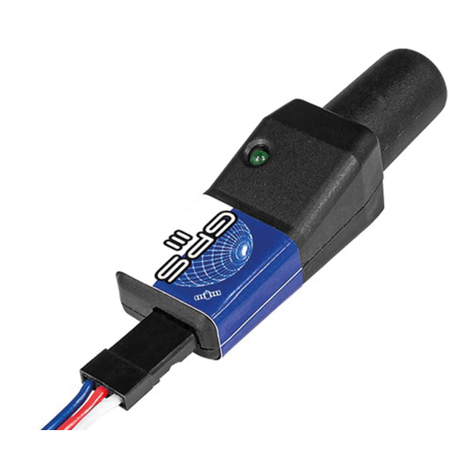
8PowerBox-Systems − World Leaders in RC Power Supply Systems
The switch should be mounted in the fuselage side. As with previous units, a
wooden doubler should be glued to the inside of the switch aperture - especially
if the fuselage is made of GRP - in order to avoid subjecting the switch to pow-
erful vibration. The set includes a template for the switch aperture. An exposed
switch is often undesirable in scale models, and for such applications we offer
an alternative switch in the shape of the MagSensor. However, please note that
the SensorSwitch is required for the programming procedure - unless you are
using a Core or Jeti RC system - and for this reason it should always be available
for use. The SensorSwitch is plugged into the socket marked Switch on the side
of the PowerBox.
b) Receivers
Once you have installed the PowerBox Royal SR2, the screen and the switch, it is
time to connect the receivers. In principle all SRS PowerBox systems are totally
reliable when used with a single receiver. However, in view of the low cost of a
second receiver compared with the value of the model, we always recommend
installing a second receiver.
Ideally the receivers should be spaced well apart inside the model, as this increa-
ses the likelihood that at least one receiver will have good reception at all times
- even under difcult reception conditions. It is permissible to extend the serial
bus connection between receiver and backer to any length, as the signal is digital,
and therefore extremely resistant to external inuences.
The PowerBox Royal SR2 can be used with a wide range of radio control sys-
tems: PowerBox CORE P²BUS, Futaba S.BUS2, Jeti EX-BUS, Spektrum SRXL2,
Multiplex M-Link and Graupner Hott. The rst four systems share one common
feature: servo signals and telemetry data are carried on a bus system, and this
allows the receivers to be connected to the Royal SR2 using a single patch lead
each. Multiplex and Hott systems require an additional connection between the
telemetry output of the PowerBox and the receiver’s telemetry input.
The Royal SR2 automatically detects the system to which it is connected. Ho-
wever, when the radio is rst switched on it may take a few seconds before the
system is unambiguously recognised. Once detected, the unit stores the system
type, and it will start immediately next time it is switched on.
• PowerBox CORE
Connect one or two receivers to RX1 and RX2 at the P²BUS output. If only one
receiver is to be used, it must be connected to RX1 to provide telemetry trans-




























